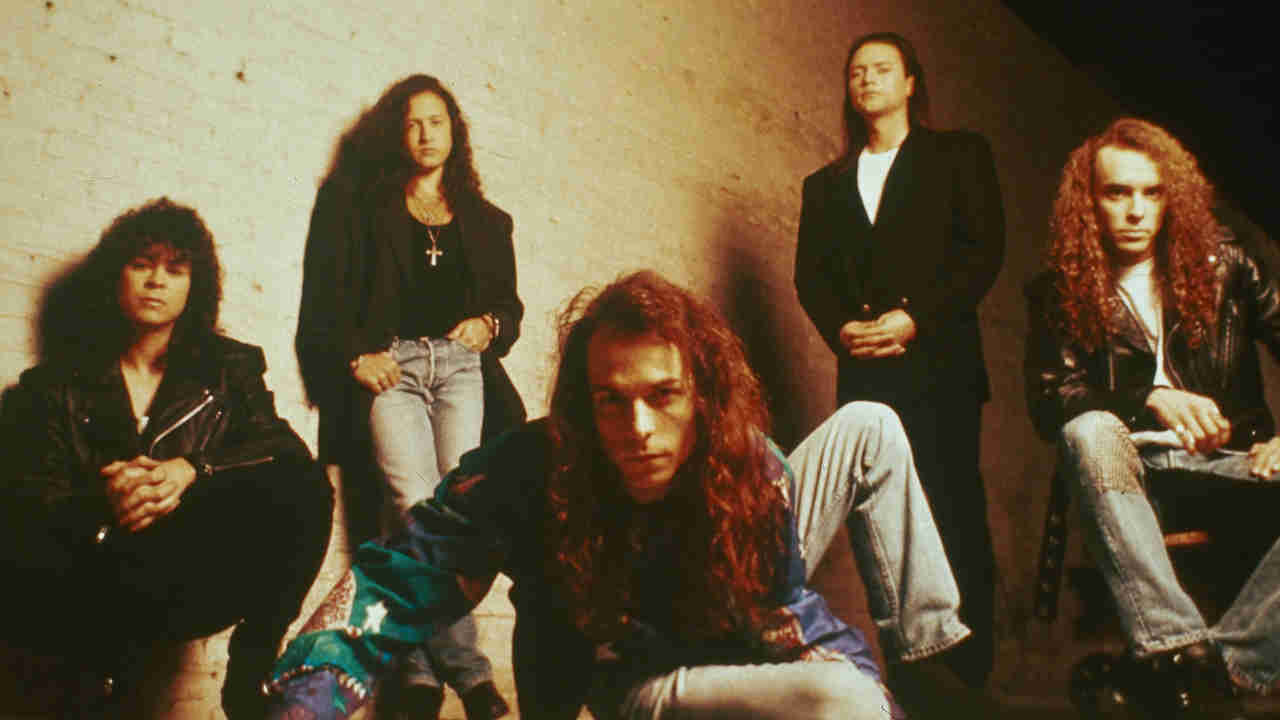Memorably described as ‘The Thinking Fan’s Metal Band’, Queensrÿche rose above the pack in the 1980s to deliver music that was as intelligent and elegant as it was hard-hitting. At their peak in the late 80s and early 90s, their forward-looking albums bridged the gap between state-of-the-art metal and the progressive metal movement that would soon emerge in their wake. The Seattle five-piece’s story began in 1981, when singer Geoff Tate, guitarists Chris DeGarmo and Michael Wilton, bassist Eddie Jackson and drummer Scott Rockenfield recorded a four-track demo under the name The Mob.
When they discovered the existence of another band with the same monicker, they opted to rechristen themselves Queensrÿche, after a track on the demo, . Those four demo tracks appeared on the band’s self-titled debut EP, released in 1983 via Seattle independent label 206 Records. The EP generated a huge buzz, bagging them a deal with major label EMI-America, who put out their full-length debut album, (1984) and the boundary-pushing (1986).

But it was 1988‘s masterful concept album that gave Queensrÿche their long-overdue breakthrough, selling more than a million copies in the US. A lot was riding on the follow-up, a record that would eventually be titled . “Chris [DeGarmo] and I had agreed from the early days that we’d alternate between a concept album and a collection of unconnected songs,” says Geoff Tate.
“So, we’d done , now it was time for something else. However, I was already working on ideas for what would be [2006’s] , the conclusion of the story. So, it was Chris who came up with a lot of .
” The band was very much driven at the time by Tate and DeGarmo, who had a firm grip on the creative process, with the full co-operation of the other three members. “The framework for the songs had been worked out before we started to record, because in those days it was a very costly process being in the studio,” says Tate. “But obviously a lot of the songs matured as we went along.
” Sign up below to get the latest from Metal Hammer, plus exclusive special offers, direct to your inbox! The man chosen to produce the project was Peter Collins, the Englishman with whom they’d worked on to such great effect. “He was the only choice for the album,” insists Geoff. “We’d had such a great relationship with him on the previous record that there was no need to change anything.
Peter is such an excellent administrator and organiser. We started off doing basic tracks at Triad Studios in Seattle, where we did the first EP, and then moved to Vancouver Studios for about two months, before mixing at Royal Recorders in Wisconsin.” The band began recording the album in the Spring of 1990.
Collins insisted that the band should follow a definite and disciplined routine. Work would begin daily at about 10am, carrying on until 11pm, although there were two meal breaks. And this would happen seven days a week.
“Peter put lunch and dinner breaks into the schedule, and demanded that everyone adhere to them,” says Tate. “It’s easy to get carried away with being in the studio, and overworking to the point where you burn out, which does nobody any good. Peter ensured we were well fed, and had the time to sleep.
” That’s not to say more traditional rock’n’roll activities were completely off the agenda. “We hired a house in Vancouver a few miles from the studio. So, we could all do what we wanted after 11pm.
And, yes, we had a lot of times when we did go out and get very...
recreational. As long as we were back in the studio the next morning, ready to work.” The simpatico working relationship the band had struck up with Collins on continued here.
“The great thing about Peter was that he never got in our way, creatively,” says Tate. “He was certainly someone with ideas, but was never a dictator. And because he was so disciplined, it meant that we actually recorded the album without overspending.
We’d learnt our lesson the hard way on , which was a bad experience. That had gone so far over budget the label were furious with us, and did very little marketing or promotion. Peter pulled in on time and without extra expense, which meant we got full marketing support.
That happened again on .” Where had been defined by its concept – a fictional, conspiracy-based narrative centred on a troubled hitman hired by a shady organisation – jettisoned any such overarching themes. Instead, songs such as , , and the sleek yet seething title track dealt with everything from social issues to personal relationships.
The album was also home to one of Queensrÿche’s greatest songs. was a billowing, dreamlike ballad that owed more to Pink Floyd as it did Metallica. Part of its grandeur came from the lush orchestration courtesy, courtesy of late American composer Michael Kamen .
“I remember so well the day Chris first played me the song at his house, on an acoustic,” says Tate. “When it finished he said, ‘I’m thinking we should get in Michael Kamen.’ We’d met him in London when we were working on .
Our producer, James Guthrie, had introduced us, and we worked with Michael on arrangements for and . He was the perfect man for the task here. “We had the song in the bag, and then Michael’s tape turned up in the mail, as usual.
I recall Peter, Chris and I were sitting in the control room when the tape rolled, and we were just blown away by what Michael had done. It was beautiful – too long, which was always the case with him, but it gave us all goosebumps.” When it came to naming the album, there was only ever one choice.
Like the song itself, the title was punchy and concise, but carried multiple meanings. “I’d come up with the song , and Chris saw it as the best possible title,” says Tate. “I liked the strong feel it had, and the fact that it reflected an album full of powerful songs.
Chris and I always had a trusting relationship. If one of us had an idea, then usually the other would accept it, unless there was a good reason to object. As I had no opposing viewpoint, I gave it my blessing.
And it was a great choice.” was released in August 1990. Propelled by the success of , it peaked at No.
7 on the Billboard charts and sold more than three million copies – still most biggest selling album of Queensrÿche’s career. But its success was a double-edged sword. It would be another four years before they released a follow-up, 1994’s darker , by which point grunge had completely changed the landscape (ironic, since they shared a hometown with Nirvana et al).
While Queensrÿche didn’t suffer the same extinction-level event as some of their contemporaries, continuing to release a string of albums, they never scaled the same heights again. Chris DeGarmo left the band in 1997, to be replaced by a string of different guitarists. Tate admits he doesn’t often listen to his band’s old albums, though he’s happy with the way turned out.
“The fact that it had so many radio- friendly songs helped,” he says. “It hasn’t dated at all. I don’t pretend that it’s a contemporary- sounding record – it has a distinct arena sound.
The drums, the guitars...
everything sounds big, because of the rooms we used. It doesn’t sound like a 90s album, with all the ambience of that era. We were definitely on a creative high Malcolm Dome had an illustrious and celebrated career which stretched back to working for magazine in the late 70s and in the early 80s before joining at its launch in 1981.
His first book, , published in 1981, may have been the inspiration for the name of a certain band formed that same year. Dome is also credited with inventing the term "thrash metal" while writing about the song in 1984. With the launch of Classic Rock magazine in 1998 he became involved with that title, sister magazine Metal Hammer, and was a contributor to Prog magazine since its inception in 2009.
. “Putting out a concept album about Moby-Dick could be career suicide”: Mastodon explain why Leviathan is so obsessed with the white whale Melt Banana's 3+5 is one of the extreme albums of the year. It's also completely off its baps The 11 best new metal songs you need to hear right now.



















